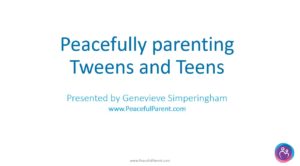Download the PDFs of the slideshows
Click any of these four images to open up and download the PDF from that slide show.
This is the case study I referred to on the Saturday professional development workshop in Queenstown. Please only share amongst teachers and make sure everyone understands the importance of not making a case study public to ensure protecting the identity of parent and child.
Parenting issue: 3.5 year old has been hitting and lashing out at mum and other children at kindy.
Approaches already used: Mum is very embarrassed by this and says she doesn’t know why he is doing it. He gets bribed with weekly trips to the warehouse and told to stop. The child is constantly asking her if she has a toy for him in the car or if they can go to the warehouse to buy something.
Sam, our Peaceful Parenting Instructor (who was still in training at that point) describes the approaches she took to support the child, the mother and the other teachers so that everyone could work together to help the child develop more security and begin to come out of the stress response. The result was a much more secure and settled child who could play well with the other children and who no longer lashed out or disrupted the other children’s play. Or if he did, he became more open to gaining the support of the teachers to get back on track.
Compassionate Education
Here’s a little excerpt from my current feature article Compassionate Education in the Natural Parent Magazine. Now, what about learning to hold a pencil and write, learning to read, learning to add and subtract. Are children equally driven by this same spirit of adventure, this same burning desire to achieve the outcome that consumes them with a similar intensity as that desire to conquer the monkey bars, ride their bike or that skateboard trick? Or would some children feel released and super enthusiastic to run outside and get back to the monkey bars or whatever they’re passionate about as soon as the teacher or parent releases them from their “learning tasks”?
Manufactured motivation. Teachers and parents know that many, if not most, children are not being driven by intrinsic motivation to achieve their school tasks. But the link isn’t always made that this results in a lack of passionate enthusiasm and hence grit and persistence to apply to their tasks. The lack of intrinsic motivation puts the teacher and student alike in a very difficult situation. The child knows the adult wants them to not only achieve their tasks, and to do so enthusiastically. The child doesn’t feel enthusiastic. The adult has to somehow keep figuring out how to manufacture the motivation needed to keep the child on task. And this is where it’s all too tempting to rely on motivating children through fear and desire, be it the desire to be in the top 30% of the class when tested or the fear of embarrassment and possible criticism of being in the bottom 30%.
Is there another way? What if the child achieving their learning goals and tasks could happen in a way that the child was following their intrinsic motivations to conquer skills and achieve goals that they have themselves set and are excited about? How can this be achieved in a classroom with a large group of children with only one teacher guiding and supporting them? How can this be achieved in homes?
When children get upset and complain that “it’s not fair”
I’m sharing these videos because I mentioned on the Tears and Tantrums workshop that I would share these with some of you, as they cover some of the concepts I spoke about on that day. On that workshop I talked about how to respond to the child whose sibling was the centre of attention and receiving presents on their birthday. We need to get the balance between not dismissing the child’s feelings, not making them wrong for being sad, not to moralise them to change their mind, e.g. “when it’s your birthday then … “. It’s hard for us parents to be ok with the child’s disappointment and upset, but that is our big emotional work that ultimately supports their emotional development. To hold space for their disappointment and help them feel it and work through it. The tears and tantrums PDF with the information in there on tantrums could be a good accompaniment to the approaches shared in these Parts I and II videos.
These two videos, part I and part II, were recorded in response to a very common question that was asked by Seonaid one of our Peaceful Parenting Instructors (then in training). Seonaid asked about how to best deal with her children complaining “it’s not fair” and whether or not to make everything even and fair. This video covers a lot of the information that I covered on the Tears and Tantrums workshop on the Sunday afternoon in Queenstown. Reframes that make it easier to cope with your child’s upsets. Guidelines for helping your child work through their upsets.


















